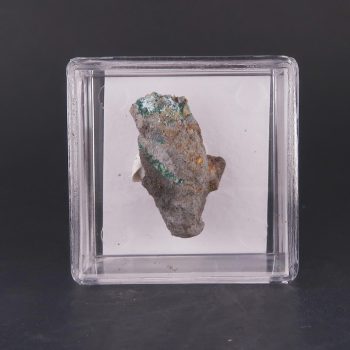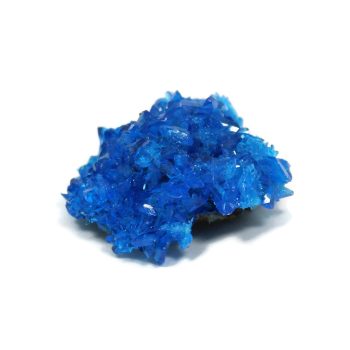Chalcanthite
An unnatural, almost alien looking blue Copper based mineral which does occur naturally but is often lab grown for collectors.
Chalcanthite is water soluble, which can cause a few problems – one, that the mineral can only really naturally be found in arid regions, and two, that storage is a concern as the mineral needs to be stored in the correct humidity.
Showing all 2 results
-

Brochantite and Serpierite from Ystrad Einion Mine, Wales
£5.00 -

Chalcanthite Specimens (Lab Grown)
£5.00
Information about Chalcanthite
Appearance
Chalcanthite occurs in a few different shapes, but the most popular is a bright blue-green crystalline formation. The pieces most popular with collectors are generally prismatic or tabular crystals on a stone matrix.
Uses and History
Chalcanthite can be used as an ore of Copper – although, given its solubility, it is only viable as an ore in the driest regions.
It is also prized as a mineral specimen, due to its beautiful colours and unusual growths. Unfortunately, the same applies – they are unlikely to be found outside the driest regions.
Locales
Chalcanthite naturally occurs in several countries, including Australia, Austria, Chile, Czech Republic, France, Germany, Greece, Italy, Morocco, Namibia, New Zealand, Norway, Peru, Poland, Portugal, Serbia, Spain, the UK, and the USA.
However, lab grown specimens are significantly more common than natural pieces – high quality natural specimens are few and far between!
Mineralogy
Do not taste test Chalcanthite; it is poisonous.
Hazards and Warnings
Chalcanthite is poisonous when dissolved in water. It should not be taste tested, and it should never be placed in water – especially a natural water source. It has been used as an insecticide and rat poison.
Almost all rocks, minerals (and, frankly, almost all other substances on earth) can produce toxic dust when cutting, which can cause serious respiratory conditions including silicosis.
When cutting or polishing rocks, minerals, shells, etc, all work should be done wet to minimise the dust, and a suitable respirator or extraction system should be used.
Translations
Arabic:
Hindi:
Portuguese:
- Calcantite
Bengali:
Indonesian:
Punjabi:
English:
Italian:
- Calcantite
Russian:
- Халькантит
French:
- Chalcantite
Japanese:
- 胆礬
Spanish:
- Chalcantita
- Calcantita
- Chalcanthita
- Chalkanthita
German:
- Chalkanthit
- Chalcanthit
- Chalkantit
- Kupferchalcanthit
Korean:
Thai:
Gujurati:
Mandarin and Traditional Chinese:
- 胆矾
Urdu:
